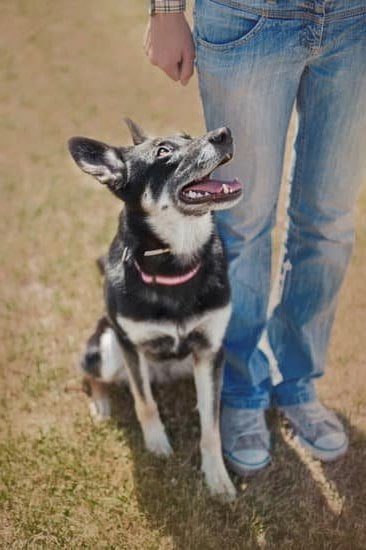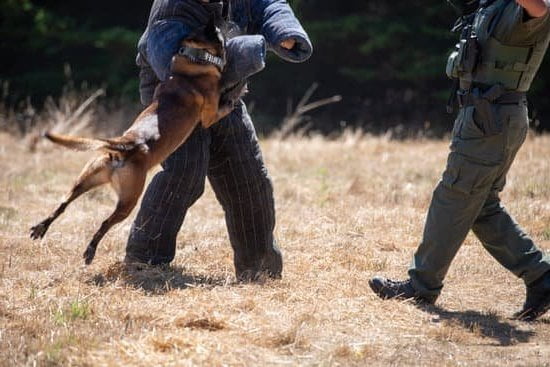Are you wondering how to train an older dog to be obedient? It’s not too late to teach your furry friend some new tricks.
Older dogs may have a reputation for being set in their ways, but with the right approach, they can learn and adapt just like their younger counterparts. In this article, we will explore the psychology of older dogs and their ability to learn new behaviors, as well as provide practical tips for training your mature canine companion.
As dogs age, their behavior and learning abilities can change. Understanding the basics of how older dogs think and learn is essential for effective training.
We will delve into the psychology of older dogs, debunking myths about their inability to learn new behaviors, and highlighting the factors that can influence their ability to be obedient. By gaining insight into the inner workings of your older dog’s mind, you will be better equipped to tailor your training approach to suit their specific needs.
Assessing the situation is crucial when it comes to training an older dog. Each dog has its own unique set of behavioral challenges, and setting realistic training goals is essential for success.
We will discuss how to identify specific behavioral issues in older dogs and establish achievable objectives for training. By taking the time to understand your older dog’s individual quirks and limitations, you can create a tailored training plan that sets both you and your furry friend up for success.
Assessing the Situation
Identifying Behavioral Challenges
When it comes to training an older dog to be obedient, it’s essential to first identify the specific behavioral challenges that need to be addressed. This could include issues such as leash pulling, excessive barking, or separation anxiety. By pinpointing these challenges, you can tailor your training approach to focus on addressing each specific behavior.
Setting Realistic Training Goals
Once you have identified the behavioral challenges, it’s important to set realistic training goals for your older dog. Understand that older dogs may take longer to learn new behaviors compared to younger dogs, so patience is key. Set achievable milestones for your dog’s progress and celebrate small victories along the way.
How to Train an Older Dog to Be Obedient
Training an older dog to be obedient requires a different approach compared to training a younger dog. It’s important to understand that older dogs may have ingrained habits and behaviors that are more challenging to change. Positive reinforcement techniques such as using treats or praise can be effective in encouraging obedience in older dogs. Consistency and patience are crucial when training an older dog, as they may take longer to grasp new commands and behaviors.
By identifying specific behavioral challenges, setting realistic training goals, and implementing proven positive reinforcement techniques, you can effectively train your older dog to be obedient. Remember that seeking the assistance of a professional dog trainer can also provide specialized guidance and support if needed.
Establishing Leadership
Building a strong and respectful bond with your older dog is crucial in establishing yourself as the pack leader. This foundation will create a relationship based on trust, respect, and clear communication, making it easier to train your older dog to be obedient.
One of the key aspects of establishing leadership is through consistency and confidence. It’s important to set clear rules and boundaries for your older dog and consistently enforce them. This includes being consistent with commands, expectations, and rewards. Dogs thrive in environments where they feel secure and understand their place within the pack, so consistency will help reinforce this understanding.
In addition to consistency, showing confidence in your role as the leader is equally important. Dogs can sense when their owners are unsure or anxious, which can lead to confusion or resistance in training. By exuding confidence in your commands and interactions with your older dog, you are effectively communicating your leadership role.
| Topic | Example |
|---|---|
| Consistency | Consistently enforcing rules and boundaries |
| Confidence | Show confidence in commands and interactions |
Positive Reinforcement
As your older dog continues to learn and adapt to new behaviors, positive reinforcement can be an effective tool in encouraging obedience and good behavior. Implementing reward-based training methods can help establish a positive relationship between you and your dog, as well as reinforce desired behaviors.
Here are some effective reward-based training methods to encourage obedience and good behavior in older dogs:
- Use treats: Utilize high-value treats that your older dog finds irresistible as a reward for obeying commands or displaying good behavior. This positive association with treats can motivate your dog to listen and follow your instructions.
- Offer praise: Verbal praise and physical affection, such as petting or gentle scratches, can also serve as powerful rewards for older dogs. Positive reinforcement through praise can strengthen the bond between you and your dog while encouraging obedience.
- Utilize toys: For some older dogs, playing with their favorite toy can be a significant reward for demonstrating good behavior. Incorporating playtime into training sessions can make learning more enjoyable for your dog.
It’s important to note that each older dog is unique, so it’s essential to experiment with different types of rewards to determine what motivates them best. By using positive reinforcement effectively, you can foster a cooperative and obedient attitude in your older dog.
Remember that consistency is key when implementing reward-based training methods. Be sure to consistently reward good behavior and immediately address any undesirable behavior without resorting to punishment.
By incorporating these effective reward-based training methods into your approach, you can create a supportive environment for your older dog to learn new behaviors and become more obedient over time.
Consistency Is Key
As your dog gets older, it’s important to establish a consistent training routine to ensure successful obedience. Consistency is key when it comes to training an older dog to be obedient. Here are some tips on how to create a structured training routine and maintain consistent expectations for your furry companion:
1. Set a schedule: Establishing a regular schedule for training sessions, feeding times, and potty breaks can help your older dog understand what is expected of them. This consistency will make it easier for them to learn new behaviors and follow commands.
2. Use the same cues: Whether you’re teaching your older dog to sit, stay, or come, using the same verbal and hand cues each time will help reinforce their understanding of these commands. Consistency in the way you communicate with your dog is essential for effective training.
3. Keep expectations uniform: It’s important to maintain consistent expectations for your older dog’s behavior both inside and outside the home. For example, if you don’t want them jumping on guests, make sure this behavior is not tolerated at any time.
By creating a structured training routine and maintaining consistent expectations for your older dog, you can improve their obedience and overall behavior. Remember that training an older dog takes time and patience, so be persistent in your efforts and always use positive reinforcement techniques to encourage good behavior. With dedication and consistency, you can train your older dog to be obedient in no time.
For more specific details on how to train an older dog to be obedient it might become necessary that you seek assistance from professional guidance or support from a professional dog trainer who can provide tailored strategies for your individual situation with your aging pet.
Patience and Persistence
Training an older dog to be obedient requires a different approach compared to training a puppy. Older dogs may have established behaviors and habits that can be challenging to change, but with patience and persistence, it is possible to teach them new tricks and commands. It is important to understand that older dogs may take longer to learn, but with the right techniques and consistency, they can become well-behaved and obedient companions.
One of the key aspects of training an older dog is understanding their limitations and abilities. Just like humans, older dogs may have physical limitations or health issues that can affect their learning capabilities. It is important to take these factors into consideration when developing a training plan for your older dog. By being patient and understanding their unique needs, you can create a positive learning environment for your furry friend.
When training an older dog to be obedient, it is crucial to use positive reinforcement techniques. This means rewarding good behavior with treats, praise, or affection. Older dogs respond well to encouragement and will be more motivated to learn when they are rewarded for their efforts. By using positive reinforcement, you can effectively teach your older dog new commands and encourage them to exhibit good behavior.
| Key Aspect | Details |
|---|---|
| Understanding Limitations | Consider physical limitations or health issues of the older dog |
| Positive Reinforcement | Reward good behavior with treats, praise, or affection |
Adaptation and Flexibility
When training an older dog to be obedient, it’s important to understand that their needs and abilities may differ from those of younger dogs. Older dogs may have physical limitations, health issues, or cognitive decline that can affect their learning process. This section will provide insights on how to adapt training techniques to accommodate the unique needs and abilities of older dogs.
Understanding Physiological Changes
As dogs age, they may experience changes in their sensory perception, mobility, and cognitive function. It’s essential to take these changes into consideration when designing a training program for an older dog. For example, if your dog has arthritis or joint pain, you may need to modify certain commands that require physical exertion. Additionally, older dogs may have decreased hearing or vision, so using visual or tactile cues in training can be more effective.
Modifying Training Methods
Older dogs may not have the same energy levels or stamina as younger dogs, so training sessions should be shorter and less physically demanding. Break down training exercises into smaller steps and offer plenty of breaks to prevent fatigue. Use gentle and positive reinforcement techniques to motivate and encourage your older dog throughout the training process. It’s also important to be patient and understanding, as older dogs may take longer to grasp new concepts.
Accommodating Health Issues
It’s crucial to consider any health issues or chronic conditions that your older dog may have when developing a training plan. Consult with your veterinarian before starting a new training regimen to ensure that it won’t exacerbate any existing medical issues. Modify exercises and activities based on your dog’s physical capabilities and always prioritize their comfort and well-being during training sessions.
By being adaptable and flexible in your approach, you can create a positive and supportive environment for your older dog as you work towards improving obedience and behavior. Understanding the unique needs of older dogs is key in developing a successful training program for them.
Seeking Professional Help
In conclusion, training an older dog to be obedient requires patience, understanding, and a commitment to consistency. Older dogs have the ability to learn new behaviors, but it may take more time and effort compared to training a younger dog. It is important to understand the psychology of older dogs and assess their specific behavioral challenges in order to set realistic training goals.
Establishing leadership and building a strong bond with your older dog is crucial in gaining their respect and trust. Implementing positive reinforcement techniques and maintaining consistency in your training routine will help encourage obedience and good behavior. It is also important to be patient and persistent, as training an older dog takes time and dedication.
Adapting training techniques to accommodate the unique needs of older dogs is essential, as every dog is different. However, if you find that you are struggling to make progress or if your older dog has complex behavioral issues, seeking professional help from a certified dog trainer may be the best option.
A professional can provide specialized guidance and support tailored to your older dog’s specific needs, ultimately leading to a more obedient and well-behaved pet. Remember that with the right approach and commitment, it is possible to train an older dog to be obedient.
Frequently Asked Questions
Can a Dog Be Too Old for Obedience Training?
Dogs of any age can benefit from obedience training, including older dogs. It may take more patience and consistency, but older dogs are still capable of learning new behaviors and commands.
How Do You Train an Older Dog to Be Disobedient?
Training an older dog to be disobedient is not something a responsible pet owner should aim for. Instead, focus on positive reinforcement and proper training techniques to encourage good behavior, regardless of the dog’s age.
How Do You Teach an Older Dog Obedience?
Teaching an older dog obedience requires patience, consistency, and positive reinforcement. Use rewards such as treats or praise to reinforce desired behaviors, and consider seeking professional help if you encounter difficulties due to the dog’s age or previous training experiences.

Welcome to the blog! I am a professional dog trainer and have been working with dogs for many years. In this blog, I will be discussing various topics related to dog training, including tips, tricks, and advice. I hope you find this information helpful and informative. Thanks for reading!





